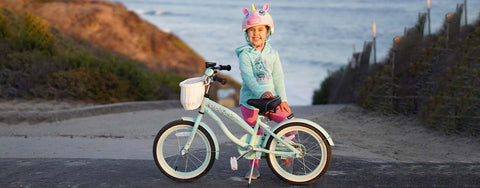How to Teach a Kid to Ride a Bike
Learning how to ride a bike is a rite of passage and a lifelong skill. Many of us still recall the feeling of freedom and accomplishment when we coasted on two wheels for the first time.
First, here are some general tips for teaching a child to ride a bike:
- Reinforce success to help the child build confidence.
- Be patient and don’t try to force the process: Your child may not be pedaling right away but with continued practice, they'll get it. Take a break and come back to it.
- Pay attention to signs you should stop and rest.
- Remember that children learn differently and may respond to some methods better than others. Learn what works and adapt as needed.
- Above all, keep it fun.
When Is a Child Ready to Ride a Bike?
There’s no right or perfect age to learn to ride a bike. The timing will depend on the child’s physical and mental development, comfort level and coordination. If they don’t have the strength to pedal, you can either wait until they’re bigger, or you can introduce them to balance bikes, which let them get a feel for coasting and balancing by pushing the bike along with their feet. Even very small children can get started this way.
The biggest factor, however, will be whether they want to learn to ride a bike. If you think they “should” learn to ride but they don’t express any interest, you may want to wait until they are ready. At REI, our classes teach kids how to ride a bike starting from age 5 and up, though many kids start much later.
Make Sure Your Child’s Bike Fits Properly
It’s critical to find a bike that fits your child. Make sure they can stand over the top tube with both feet planted on the ground. Avoid getting a bike that is too large, hoping your child will grow into it, because it will be harder for them to handle and control. (A slightly smaller bike is preferable to one that is too big.) Many kids worry about falling when they first learn to ride a bike; if they’re able to step down when they need to, this will ease some of those concerns.
Check the reach—that’s the distance from the bike seat to the handle bars. The child should be able to reach the handlebars without leaning too far forward. If the bike has hand brakes, make sure the child can comfortably reach and squeeze them.
For tips on choosing a kid’s bike, see our article How to Choose Kids’ Bikes.
Make Sure Your Child Has a Proper Helmet
Your child should wear a bike helmet every time they ride, even if it’s just down the street or around the school blacktop. To protect your child’s head from serious injury, make sure you get a helmet that fits and is also worn properly.
Here are tips for getting the proper bike helmet fit:
- The helmet should sit level across the middle of the child’s forehead, no more than 1" above the eyebrows. If the helmet sits high on the forehead or moves more than 1" when you push the helmet from side to side or front to back, adjust the fit or try a different size.
- Adjust the side straps so that they form a “V” as the straps rest under each ear.
- Buckle the chin strap, making sure it’s snug. You should only be able to slip one or two fingers between the strap and chin. The helmet should not rock back and forth on the head.
You might also consider gloves, elbow and shin guards, knee pads and closed-toe shoes. Be sure shoelaces are tucked out of the way and avoid loose pant legs. Have them wear long socks or pants, because sometimes the pedals and crank arms may smack their ankles.

This method for teaching a child to ride a bicycle emphasizes balancing on two wheels first and adds pedaling later. Generally, kids who start on a balance bike tend to have an easier time learning to ride a bike than those who start on training wheels. Balance bikes are designed to get your kids to practice balance first, but it's easy to modify a standard child's bike as well:
- Remove training wheels. Training wheels help kids get accustomed to sitting on a bike and using their legs to pedal, but they don’t help them learn to balance.
- Remove the pedals and lower the seat: This allows kids to sit upright with a slight bend in their knees and their feet flat on the ground. The goal is to help them feel more comfortable and steadier as they begin to learn balance. (Note: Pedals can be removed most easily using a pedal wrench.)
- Properly inflate the bike tires. The bicycle will roll more smoothly and your child will have an easier time coasting when bike tires are inflated to the correct pressure. Look for the recommended tire pressure printed on tire sidewalls.
Where to Teach Bike Riding
Find a traffic-free paved area that is large, flat and smooth such as an empty tennis or basketball court or a school blacktop. Avoid narrow trails and short driveways because you don’t want kids to worry about going off the pavement. Grassy areas are also tougher because kids can’t get enough speed on them to learn to coast and glide.


Dejar un comentario